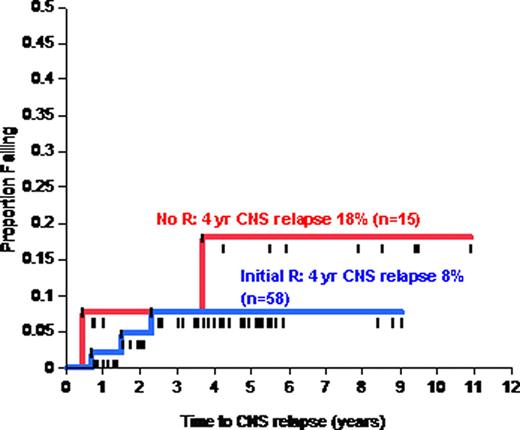Abstract
Abstract 2804
The role of intrathecal (IT) chemotherapy prophylaxis for CNS relapse of diffuse large B cell lymphoma (DLBCL) is unclear. Proponents cite its safety, the lethality of CNS relapse if it occurs, and the high risk of CNS relapse among some DLBCL patients (pts). Rituximab (R)-containing therapy may be associated with a lower incidence of CNS relapse than prior regimens. To assess the efficacy of IT prophylaxis in a modern cohort, we analyzed survival and CNS relapse in DLBCL pts receiving IT prophylaxis at our center from 1998–2008. The impact of baseline clinicopathologic features and R exposure on CNS relapse risk were explored.
Adult pts with DLBCL receiving IT MTX and/or Ara-c from 1998–2008 were identified from pharmacy records, with IRB approval. All pts had involvement of >1EN site, sinus/testis/epidural involvement, and/or bone marrow involvement by large cell lymphoma. Inclusion criteria: IT given as part of first-line DLBCL therapy, no other CNS prophylaxis given, at least 60 days follow-up from diagnosis. Kaplan-meier estimates of survival and CNS risk outcomes were generated. The impact of tumor cell of origin (IHC/Hans criteria), Ki67 index, age, extra-nodal (EN) sites, stage, LDH, IPI, BM involvement, RP node involvement, and first-line R on outcomes were assessed.
121 pts were identified, 73 of whom met inclusion criteria. The median age of reviewed patients was 63 years (range 26–84). 63% were male. 2 pts had HIV. At baseline, 59% had IPI score of 3–5, 30% had B symptoms, and 68% had elevated LDH. Median #EN sites was 2 (range 0–5). 43% had RP nodes involved. 57% had >1 EN site. 45% of pts had both elevated LDH and EN sites >1. Median Ki-67 was 80% (range 30–90%), and 26/39 (67%) assessable pts had GCB cell-of-origin DLBCL using Hans criteria. Treatment was RCHOP in 78%; it included R in 79%, and all pts received an anthracycline. IT methotrexate (MTX) 12 mg was used in all pts. 2 pts received at least 1 dose of IT ara-C. A median of 5 doses (range, 1–6) IT therapy were administered. Median follow-up is 3.7 years. 4 year OS and EFS are 77% and 58%, respectively. Five of 73 pts developed CNS relapse (3 leptomeningeal, 2 parenchymal), a relapse rate of 7% (Figure 1). CNS relapse occurred at a median 18 months from diagnosis (range, 6 – 43 months). 3 had concurrent or preceding systemic relapse; 2 relapsed only in the CNS. 3 CNS relapses occurred after initial R; all had received 3 or more doses of IT MTX. Kidney involvement was present in 2/5 CNS relapse pts, a higher proportion than others (2/68, p=.03). Kaplan-meier estimates of CNS relapse rates did not differ based on exposure to first-line R (Figure 1, p=.33). Three pts with CNS relapse died from 4–10 months from relapse. 2 pts are alive after intensive therapy (high dose IV MTX or repeat IT therapy; then salvage chemotherapy and ASCT), at 5.4 and 9.8 months from CNS relapse. Two patients required cessation of IT therapy (due to pain and spinal leak), and one died of a cryptic neurologic disorder 223 days from diagnosis while in remission; no autopsy was performed.
IT chemotherapy prophylaxis and CNS relapse risk based on first-line R (p=.33)
We conclude that IT prophylaxis is a safe and reasonable strategy in the RCHOP era, when applied to pts at high risk of CNS relapse based on pattern of EN disease. The observed rate of relapse resembles that seen in a recent study incorporating IV MTX with first-line RCHOP for similarly high-risk pts (Abramson et al, Cancer June 2010). No difference in CNS relapse rate between first-line R and no R groups was observed. Prospective studies of novel first-line approaches for high-risk DLBCL pts should incorporate or allow IT prophylaxis.
Dean:Genentech: Speakers Bureau.
Author notes
Asterisk with author names denotes non-ASH members.


